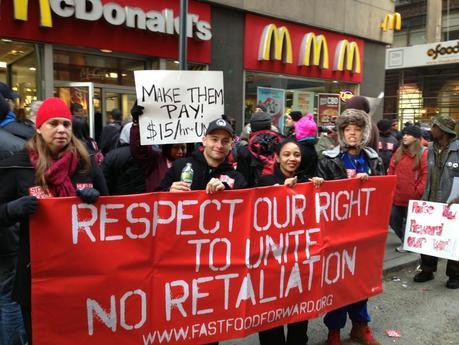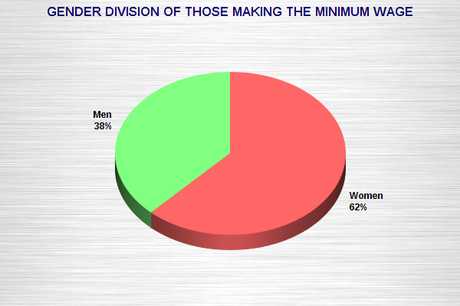 (This photo shows fast food workers in New York joining the demonstrations. It was found at the website Labor Notes.)
(This photo shows fast food workers in New York joining the demonstrations. It was found at the website Labor Notes.)Yesterday, thousands of fast food workers demonstrated in over 150 cities for higher pay and the right to unionize. And if demonstrations were ever justified, these certainly were -- because fast food workers are among the lowest paid workers in this country, and they have little or no recourse to correct that. All American workers should be unionized. That is the only way to protect their rights on the job, and to make sure they get to share in rising production.
These workers were asking for a raise to $15.00 an hour. That is not as unreasonable as you might think -- amounting to only about $31,200 a year (still more than $10,000 a year less than the country's median wage). I imagine they would settle for less though, as long as it could get them out of poverty -- and the proposed raise in the minimum wage to $10.10 an hour would do that for most (although just barely).
Here are a couple of charts from the Pew Research Center about the current minimum wage.


There are two glaring facts about the minimum wage. First, it is a poverty wage. Second, it affects women far more than men. About 62% of those making the minimum wage ($7.25 an hour) are women, and many of them are single parents trying to support a family. Currently about 5.4% of working women make at or below the minimum wage, and 3.3% of irking men make at or below the minimum wage. That's about 2.1 million women and 1.2 million men, for a total of 3.3 million Americans making at or below the minimum wage.
That would be bad enough, but it really is just the tip of the iceberg. There are many millions of workers that earn just slightly above the minimum wage -- like those striking fast food workers (where the average wage is about $8.94 an hour). That's still a poverty wage, even though it's above the pitiful minimum wage. And the situation is not getting any better. Most of the good-paying jobs lost in the recession are being replaced by low-wage jobs (making at or slightly above the minimum wage -- with few or no benefits). It is estimated that by 2020 (just six years from now), about 25% of the American workforce will be in these low-wage jobs (about one out of every four workers).
The Republicans, who have successfully blocked a raise in the minimum wage so far, want you to think $10.10 an hour is an enormous wage that employers could not afford. That is a lie. Employers could afford to pay it, and they would still be getting a labor bargain -- because it only amounts to about $21,000 a year (less than half of the national median wage).
They will also tell you that raising the minimum wage will stifle economic growth. That is another lie. Those making $10.10 an hour will just be making a barely livable wage, and they will need to spend that money (on food, clothing, shelter, transpiration, and other necessities). That new spending will boost the economy by increasing sales (and profits) for both large and small businesses, and that will help create even more jobs. The truth is that raising the minimum wage to at least $10.10 an hour would be the best single thing this country could do to get the economy moving again.
And it would have a good side effect for taxpayers -- by reducing the need for government social programs (like food stamps). This would cut government spending and reduce the budget deficit -- and it would do it without hurting needy Americans. In short, raising the minimum wage to $10.10 an hour would be good for everyone -- workers, businesses, taxpayers, and the government. It needs to be done -- sooner rather than later.

